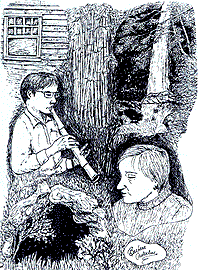BAFA © 2010. All material here is copyrighted. See conditions above. |
Barbara Casterline
painter, illustrator, Japan
|
Nagoya, Japan's third largest city, is situated in the central part of the
main island of Japan, about halfway between Tokyo and Osaka, and has been
the home of Barbara Casterline and her husband, Gail, since 1977. Barbara, a
Bahá´í, has become well-known locally as a talented artist. Recently, a
popular daytime television program, "Watashi to Nagoya" ("Nagoya and I"),
did an extensive interview with Barbara about her reasons for being in
Nagoya, her family, and her art and the reasons for her painting peoples of
various nationalities. The interview was conducted entirely in Japanese, a
difficult language, of which Barbara has gained an admirable command. She
was interviewed in several venues, at home and at places where she paints,
such as the area of older buildings near the moat of the Nagoya Castle. For
a foreigner and a Bahá´í, this interview is an astounding achievement in
Japan, where air time is extremely expensive and recognition of foreigners
rare.
Barbara paints mostly in NIHONGA, which simply means "Japanese painting,"
and includes SUMIE, the brush and water-based ink painting brought over from
China (c. 900 AD), and many other forms. The chief NIHONGA artists of today,
use, over their sumi outlines, an array of brilliant mineral pigments,
called IAW ENOGU. These are crushed from natural minerals (some quite
expensive) in various grades from powder to sandy, and mixed, using the
fingers, with a hot glue (melted over a hot plate from its stick or gelatin
state) and then with cool water.
|

|
This substance is applied with soft
brushes---wide and flat for large areas, pointed for lines and details---to
a surface of either silk or (more often) sized paper, sometimes over a
ground of zinc white. Layer after layer of semitransparent color can be
built up, with a result that has greater depth than watercolor, and greater
delicacy than oils. The crystalline bits reflect light, an effect that can
be enhanced with crushed quartzite in the whites and the use of silver or
gold leaf underlays or overlays.
Although entranced by NIHONGA for many years, Barbara did not begin studying
it until about four years ago, when she began lessons with her present
teacher. She says, "I've actually had more training in SUMIE (and related
TANSAI SUIBOKU), but feel less successful in that medium. I suppose what I'm
actually best at is watercolor, but my watercolors are less dramatic than my
NIHONGA." The Bahá´í children's book, A VIOLET IN THE GARDEN, due out soon
from Brilliant Books (Leuven, Belgium), is illustrated with her watercolors.
Besides NIHONGA and watercolor, Barbara does quite a lot of pen and ink
drawings, some pencil drawings, a few pastels---"a difficult medium for me,"
she claims. "I use acrylics only for craft projects, for they adhere nicely
to wood, but I never use oils---enough other people do." And several of her
pen and ink drawings she has had reproduced as postcards.
There are a number of living Nigonga artists, whose works are an inspiration
to her. The oldest is Yuki Ogura, born in 1895. "When I went to her exhibit
in 1994, she was still alive and painting," Barbara says. Ms. Ogura does
lively still lifes and humorous, loving portraits of her family. Kai
Kigashiyama is another inspiration. Probably the most famous living Japanese
painter (born 1908), he is known for soft landscapes. Another, Ikuo
Hirayama, has done many evocative paintings of Tibet and the wilderness of
the Silk Road. Last year, he painted two magnificent panoramas of
Itsukushima (Miyajima, the world-renowned "Shrine Island," near Hiroshima).
Another painter who inspires Barbara is Toshio Hirakawa. He does
breathtaking, TOUR DE FORCE black and white paintings of sea and rocks or
trees and snow. Her own teacher, Tetsuhiro Hoshino, does paintings, which,
for Barbara, have great depth and spiritual intensity.
Flowers have long been a theme of Barbara's "because they are beautiful and
at hand. I love grander scenes of nature too---great trees, mountains, the
sea---but getting to them takes some effort. Recently, I had some chances to
visit the sea, so I took many photos and made a few sketches. The contrast
of liquid sea and solid rock, the gorgeous colors of the water---these
excite me". Another theme is historical preservation. Barbara respects
beautiful old houses and hates to see them destroyed. And more and more, she
draws people of all ages, types and nationalities ... "as a way to show my
love for them." How did it all begin? "My mother taught my brother and me
how to use oils when we were children and often took us to museums. We're
both grateful."
Excerpts from Arts Dialogue, December 1997, pages 11-12. |
- Illustration: Arts Dialogue, October 2000
- Artist Profile: Arts Dialogue, December 1997
|

Arts Dialogue, Dintel 20, NL 7333 MC, Apeldoorn, The Netherlands
email: bafa@bahai-library.com
|
|
